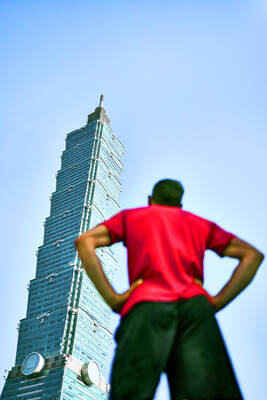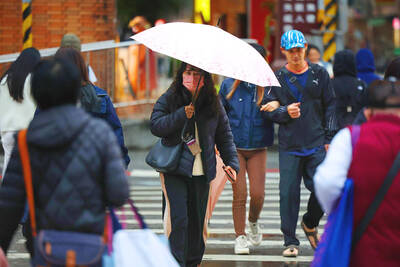China's role as the world's largest exporter of fur garments, with direct links to European and Asian countries, including Taiwan, deserves sharp criticism because of its lack of respect for life, animal rights activists from the Environment and Animal Society of Taiwan (EAST) said yesterday.
EAST released a report on the Chinese fur industry in Taipei yesterday. It is the first ever report from inside China's fur farms and is based on field and desk research carried out last year and last month.
EAST worked in conjunction with groups in Switzerland and the UK, including Swiss Animal Protection, Social Progress for Animal Welfare and Care for the Wild International.

PHOTO: ENVIRONMENT AND ANIMAL SOCIETY OF TAIWAN
At a press conference, video footage taken during researchers' visits to several farms in Hebei Province -- which were raising from 50 to 6,000 animals -- was shown for the first time to the media in Asia.
Animals such as raccoons, foxes, and minks were shown being stunned with repeated blows to the head or by being pounded against the ground. The debilitated animal was then laid on its back or hung upside-down by its hind legs from a hook, and skinning would begin, with a knife inserted in the lower belly.
According to EAST's director, Chen Yu-min (
"We suspect that consumers buying fur products don't know about the brutality involved in the process. Innocent animals suffer for the fashion vanity of humans," Chen said.
According to the report, many animals remained alive after their skin had been stripped off, with breathing, heartbeat, as well as body and eyelid movements all evident for five to 10 minutes.
The report says most Chinese fur farms were established in the past 10 years. Wild species bred for fur include red foxes, Arctic foxes, raccoons, dogs, mink and Rex rabbits.
Wu Hung (
Most animals are killed at about six months old, when they molt for the first time.
Activists said a growing number of international fur traders, processors and fashion designers have gradually shifted business to China, where cheap labor and the absence of restrictive regulations have made it easier to do business and widened profit margins.
Activists said that in the past few years designers have promoted fur in everything from evening wear to sports wear. One fur coat requires the fur of about 80 minks or 25 foxes.
Government statistics in Taiwan suggest that the amount of fur products imported from overseas has increased dramatically, rising from 1,497kg in 2001 to 9,944kg in 2003.
Fur products imported from China, meanwhile, have also increased significantly. In 2003, more than 70 percent of fur products imported were from China. Last year, the percentage rose to 85 percent.
"Why do some consumers in Taiwan, which sits in a sub-tropical area ... need fur products to keep them warm?" Chen said.
Activists said entertainers in show business should take the lead to boycott fur products.
"In China's fur industry, we don't see any spirit to help the weak and aid the needy. Seeing this crime, Taiwan should not become an accomplice," Mary Chen (

US climber Alex Honnold is to attempt to scale Taipei 101 without a rope and harness in a live Netflix special on Jan. 24, the streaming platform announced on Wednesday. Accounting for the time difference, the two-hour broadcast of Honnold’s climb, called Skyscraper Live, is to air on Jan. 23 in the US, Netflix said in a statement. Honnold, 40, was the first person ever to free solo climb the 900m El Capitan rock formation in Yosemite National Park — a feat that was recorded and later made into the 2018 documentary film Free Solo. Netflix previewed Skyscraper Live in October, after videos

NUMBERS IMBALANCE: More than 4 million Taiwanese have visited China this year, while only about half a million Chinese have visited here Beijing has yet to respond to Taiwan’s requests for negotiation over matters related to the recovery of cross-strait tourism, the Tourism Administration said yesterday. Taiwan’s tourism authority issued the statement after Chinese-language daily the China Times reported yesterday that the government’s policy of banning group tours to China does not stop Taiwanese from visiting the country. As of October, more than 4.2 million had traveled to China this year, exceeding last year. Beijing estimated the number of Taiwanese tourists in China could reach 4.5 million this year. By contrast, only 500,000 Chinese tourists are expected in Taiwan, the report said. The report

Temperatures are forecast to drop steadily as a continental cold air mass moves across Taiwan, with some areas also likely to see heavy rainfall, the Central Weather Administration (CWA) said. From today through early tomorrow, a cold air mass would keep temperatures low across central and northern Taiwan, and the eastern half of Taiwan proper, with isolated brief showers forecast along Keelung’s north coast, Taipei and New Taipei City’s mountainous areas and eastern Taiwan, it said. Lows of 11°C to 15°C are forecast in central and northern Taiwan, Yilan County, and the outlying Kinmen and Lienchiang (Matsu) counties, and 14°C to 17°C

STEERING FAILURE: The first boat of its class is experiencing teething issues as it readies for acceptance by the navy, according to a recent story about rudder failure The Hai Kun (海鯤), the nation’s first locally built submarine, allegedly suffered a total failure of stern hydraulic systems during the second round of sea acceptance trials on June 26, and sailors were forced to manually operate the X-rudder to turn the submarine and return to port, news Web site Mirror Daily reported yesterday. The report said that tugboats following the Hai Kun assisted the submarine in avoiding collisions with other ships due to the X-rudder malfunctioning. At the time of the report, the submarine had completed its trials and was scheduled to begin diving and surfacing tests in shallow areas. The X-rudder,